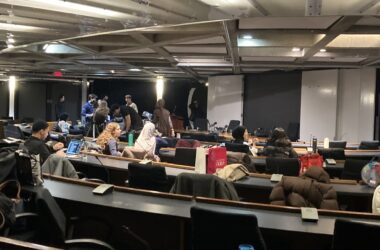Many are familiar with scrolling Letterboxd, a platform designed to rate and review movies. There, cinephiles convene over the range of emotions evoked from watching a movie—from laughing to crying, then back to laughing because you’re crying. Now, McGill students who feel the exact same range of emotions all within a one-and-a-half-hour Zoom lecture can debrief on Lecky. Lecky is a platform where students can connect with friends while reviewing lectures on a five-star scale.
Ashtyn Morel-Blake, U0 Arts, with co-collaborator Regan Heynoski, U0 Arts & Science, spearheaded the website. In an interview with The Tribune, Morel-Blake expressed that Lecky functions similarly to Letterboxd.
“If you’re a fan of Letterboxd and rating things, why don’t you also just rate your lectures when you go to them?”
Although this concept may sound reminiscent of pre-existing websites like Rate my Professors, Morel-Blake explains, “Rate my Professors is about a person. [….] [With Lecky], you actually choose which [individual] lecture you [rate].”
Because the website can be synced to McGill’s visual schedule builder, students
can type in their course code to find their lectures easily, as well as tag the date of the
lecture for more specificity. Morel-Blake intends to expand the app to allow users to share
notes back and forth, creating more opportunities for collaboration. A packed lecture hall
can feel isolating, but with Lecky, Morel-Blake hopes to foster a community where students connect through shared experiences.
Despite his skill in coding, Morel-Blake understands software engineering to be a narrowing
job market. “There’s a higher probability that that career option’s kind of dead […] for the
longest time [I wanted] to be a software engineer, […] [but now] the bar for quality of [a
software] engineer is really high. […] I hope I’m in that top five per cent”.
Aspiring software engineers are now competing with AI models that have the ability to code. Morel-Blake believes that AI can create specific apps at a fast rate, albeit with negligible craft and ‘sloppy work.’ Morel-Blake refers to this specific type of AI-usage as ‘vibe coding,’ a process where humans use plain speech to describe an app’s purpose to an AI model, which then writes a functional code. Sometimes, however, human users do not read this code. It is often only tested by using the actual app.
The newness of AI software, like ‘vibe coding,’ can engender a lack of awareness among consumers and investors about the pitfalls of relying on automatically generated code, the backbone of digital products. This naive optimism and overvaluation surrounding ‘vibe coding’ may be akin to the so-called ‘dot-com bubble.’ The ‘dot-com bubble’ of the late 90s occurred when lucrative start-ups received substantial valuations of shares in the stock market. When these companies could not deliver on their promise of profit, the ‘dot-com bubble’ burst, leading many companies to sink and resulting in massive financial losses for individual investors.
Speculating that the ‘dot-com bubble’ bears a similar mark to the vast investments AI-firms currently receive, Morel-Blake elaborates on this by suggesting that the innovation of these apps does not require comprehensive expert coding knowledge. The ease of creating has, therefore, diminished the standard for well-crafted software.
“Now we have the AI bubble, and everyone that doesn’t really know how to program and doesn’t really know what good software looks like […] [is] making all of these apps, and there’s no real expectation of quality”.
Even as AI’s inevitability takes hold, Morel-Blake’s passion for crafting and fostering community is a testament to the most enduring form of intelligence: Creative human innovation.







